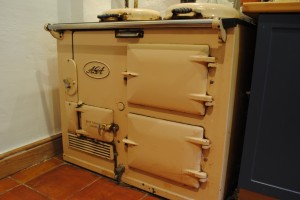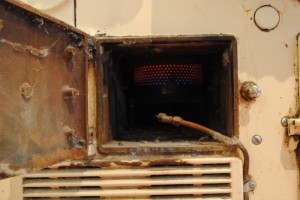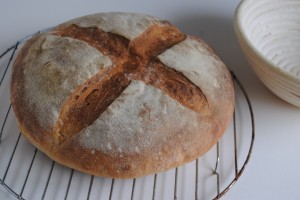AGA than life
The Aga that dominates the corner of my landlady’s kitchen has been switched off for the summer, but now that it feels a bit colder it has been fired up for the weekend. Naturally, I didn’t waste any time getting some bread together to take advantage of this.
The cooker must be at least 50 years old, and originally burned coal. It has since been converted to run on oil (in rural areas like this, most people run their heating off oil because there’s no mains gas, so the tank was already in place). Behind the hatch on the lower left-hand side of the oven is the burner, which heats the heavy cast-iron body of the oven. Although Agas are associated with English country houses, the oven was invented in 1922 by a Swedish chemist, Gustav Dalen, and the name itself is an acronym for the company he worked for, Aktiebolaget Svenska Gasaccumolator (so it should be written AGA, but this seems a bit unnatural). Like other iron range-cookers made by manufacturers such as Esse and Rayburn, an Aga is kept on constantly. Iron has a very high specific-heat capacity, which means it absorbs and stores a large amount of heat. Because of this, it also takes a long time to heat up to operating temperature – a good 24 hours from cold. As a result, there is no question of just turning it on and off as you would with a normal domestic oven-cooker: once it’s up and running, it’s kept running, although less energy is needed to keep it at operating temperature once it has got there (rather like a car, most of the energy is expended in acceleration rather than in cruising). Nonetheless, iron ranges consume far more fuel than conventional kitchen stoves, making them expensive to run and not enormously green.
Although Agas are associated with English country houses, the oven was invented in 1922 by a Swedish chemist, Gustav Dalen, and the name itself is an acronym for the company he worked for, Aktiebolaget Svenska Gasaccumolator (so it should be written AGA, but this seems a bit unnatural). Like other iron range-cookers made by manufacturers such as Esse and Rayburn, an Aga is kept on constantly. Iron has a very high specific-heat capacity, which means it absorbs and stores a large amount of heat. Because of this, it also takes a long time to heat up to operating temperature – a good 24 hours from cold. As a result, there is no question of just turning it on and off as you would with a normal domestic oven-cooker: once it’s up and running, it’s kept running, although less energy is needed to keep it at operating temperature once it has got there (rather like a car, most of the energy is expended in acceleration rather than in cruising). Nonetheless, iron ranges consume far more fuel than conventional kitchen stoves, making them expensive to run and not enormously green.
The advantage, for the baker, is that the Aga’s oven is excellent for making bread. Unlike normal ovens, the Aga’s oven chambers are very well sealed, so they retain the steam released from the baking dough and create a humid environment that allows the bread to expand fully before the crust hardens. The heat-capacity of the iron walls, meanwhile, means that the heat sucked in by the dough, which to begin with is relatively cold, is immediately replaced. In a normal oven, the heat source cannot meet this demand, and the temperature will drop quickly as soon as the dough is placed inside – just at the point when the dough needs all the heat it can get to rise and swell before the the forming crust prevents it. The only serious competition an iron range has, when it comes to making bread, is a traditional brick oven or a professional deck oven. I made a straight white Coburg to test it out – I was busy over the weekend, unfortunately, so I didn’t have time for anything more adventurous – but the results were perfect. Here’s looking forward to a very productive autumn and winter!
I made a straight white Coburg to test it out – I was busy over the weekend, unfortunately, so I didn’t have time for anything more adventurous – but the results were perfect. Here’s looking forward to a very productive autumn and winter!
